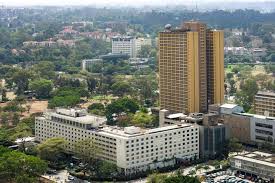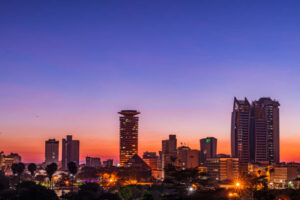
Nyati House
Introduction
Nyati House, located along Loita Street in Nairobi, holds a notorious reputation as the former headquarters of the Special Branch. This five-story building has a dark history. It is known for surveillance, abductions, and torture.
These practices occurred during former President Daniel arap Moi’s reign.Understanding Nyati House’s legacy provides insight into the systemic oppression faced by dissenters in Kenya, especially in light of the ongoing 2024 Gen Z protests against extrajudicial killings and abuses of power.
The Origins of Nyati House’s Infamy
The infamy of Nyati House stems from its role as the headquarters for the Special Branch, a division of the Kenya Police responsible for intelligence gathering and monitoring individuals deemed threats to national security.
During Josephat Karanja’s time as vice-chancellor, authorities frequently surveilled university students. This practice became commonplace. The building appears ordinary, but it hides a terrifying history. Those trapped within its walls recount chilling stories.
Tales from former detainees highlight the horror associated with Nyati House. Locals described the atmosphere of Loita Street as eerie, suggesting it had an “aura of death” due to the building’s reputation.
Many political science students heading to the Libyan Embassy for Muammar al-Qaddafi’s Green Book often faced interception by security officers. They were frequently taken by force to Nyati House for “questioning.”
A Place of Fear and Silence
From the exterior, Nyati House appears unremarkable, adorned with a Nyati (buffalo) emblem. Rumors claimed the upper floors housed torture chambers, often empty of life. In the mid-80s, a café operated at the base. Few dared to approach the gate. Researching this proved daunting. Inquiries received apprehensive glances, head shakes, or nervous laughter. The legacy of Nyati House instilled fear in those who might share information.
Security agents at Nyati House exhibited reluctance when approached for details about the building’s history or architecture. People stressed the need for authorization, warning that any inquiry could attract unwanted attention. This atmosphere of intimidation encapsulated the essence of what Nyati House represented.
The Role of the Special Branch
The Special Branch, which operated from Nyati House, was infamous for its brutal tactics. Under the leadership of James Kanyotu, who remained the longest-serving spy chief until his death in 2008, the agency engaged in extensive intelligence operations.
It focused on individuals and groups that posed perceived threats to the state, often providing information directly to President Moi.
This intelligence-gathering mechanism was sanctioned by a Presidential Charter signed by President Jomo Kenyatta in 1969, which was later reviewed by Moi in 1978. The authority granted to the Special Branch extended beyond the typical functions of law enforcement, allowing it to operate with little oversight.
In 1999, the government dissolved the Special Branch and replaced it with a new intelligence service following the National Security Intelligence Service Act.

The Heightened Climate of Repression
To contextualize the experiences of those detained at Nyati House, it is crucial to understand the political landscape during its operational years. The 1970s and 1980s saw a surge in student activism, particularly following the murder of JM Kariuki in 1975, which ignited fierce opposition against the Moi regime. The opening of Nyati House in the early 1980s coincided with this uptick in activism, marking it as a focal point of fear for dissenters.
Many university students became victims of the regime’s repression. Surveillance of student activities intensified under Karanja’s vice-chancellorship, with numerous radicals experiencing the chilling reality of Nyati House. The university transformed into a battleground for opposing political ideologies, and many students faced detention without trial, often finding themselves in Nyati House’s interrogation rooms.
Notable Detainees and Their Ordeals
Several high-profile individuals endured torture at Nyati House. For instance, security agents detained and tortured Professor Micere Mugo for two days before the 1982 coup attempt. Her ordeal highlighted the risks faced by outspoken academics during this time.The brutality she endured compelled her to seek exile in Zimbabwe and the United States.
Maina wa Kinyatti, a history lecturer at Kenyatta University, was also apprehended and mistreated at Nyati House. After refusing to cooperate, he was denied basic necessities and chained until he provided the desired “confession.” Other notable detainees included Koigi wa Wamwere and members of the Mwakenya Movement, who fought for democratic space in Kenya.
Legacy of Nyati House in Modern Protests
Today, the legacy of Nyati House resonates within the current context of the 2024 Gen Z protests. Young activists are raising their voices against ongoing abuses, including extrajudicial killings and disappearances. The history of this building serves as a chilling reminder of the state’s capacity for violence against dissenters, reinforcing the urgency of their cause.
Millennials and Gen Z individuals often pass by Nyati House, perhaps unaware of its dark significance in Kenya’s struggle for freedom. While its current function remains unclear, access to the building is heavily restricted, requiring prior appointments for entry. This guarded status continues to evoke feelings of unease among those who recall its past.
Conclusion
Nyati House stands as a testament to Kenya’s tumultuous history of political repression. As the epicenter of torture and surveillance during a time of immense fear, it encapsulates the challenges faced by those who dared to oppose authoritarian rule. In light of the ongoing 2024 protests, the stories and experiences linked to Nyati House remind society of the importance of vigilance against abuses of power and the need for a more just and transparent governance structure. We must not forget Nyati House’s legacy, as it shapes the narrative of resistance in contemporary Kenya.







